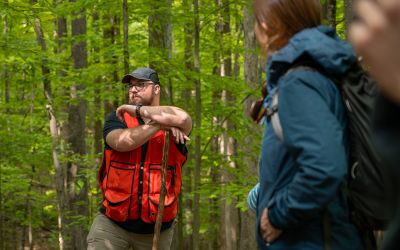Managing Invasive Plant Species in the Central Appalachian Region

American Forest Foundation Forester, Ian Forte, standing in West Virginian woods as he tells landowners about sustainable forest management practices.
The forests of Maryland, Pennsylvania and West Virginia are vast and abundant in oak, maple, pine, elm, ash and poplar trees. Over 78% of West Virginia, 60% of Pennsylvania and 39% of Maryland is woodland. These forests purify the air, filter water, store carbon and provide a home for the wide range of plant and animal species that make woodlands their home.
Maintaining a healthy forest that is sustainable, climate resilient and supports biodiversity requires keeping invasive plant species under control. In the Central Appalachian region, this often means effective management of Japanese Stiltgrass, Multiflora Rose and Japanese Barberry. The Family Forest Carbon Program helps family forest owners by providing an income stream, sustainable forest management plans and a professional forester with technical expertise to tackle tough problems like invasive species management.
Japanese Stiltgrass
Japanese stiltgrass impacts a forest by quickly crowding out native plant species, altering the nutrient cycle of the soil. It inhibits sapling growth and survival and reduces sunlight availability. As it dies in the autumn, it forms a thick blanket along the ground that decomposes at a slow rate, causing deer to browse on native plants.

The Family Forest Foundation’s foresters offer guidance that helps landowners control Japanese Stiltgrass.
Most landowners are unaware that an invasive plant is causing so much harm to sapling growth. AFF’s foresters help landowners to identify invasive species and discuss the treatments that best suit the landowner’s needs. This helps increase the success rate of sapling plantings. One FFCP landowner hadn't realized that stiltgrass was preventing the growth of dozens of saplings but with an AFF forester’s help, a workable treatment was developed so existing and future saplings could be successfully established.
Possible treatments your AFF forester may suggest, depending on your environment, are the application of postemergence herbicides after germination such as glyphosate, glufosinate, or quizalofop.
Multiflora Rose
Like Japanese stiltgrass, this noxious bush crowds out native plant species. But the multiflora rose is spread by animals foraging on the fruit and flowers, dispersing seeds rapidly throughout the area. The multiflora rose grows quickly and earlier in the year than native plants, and the thorns of the multiflora rose protect it from wildlife grazing, allowing it to easily become established in the forest.

A professional forester’s expertise helps woodland owners manage invasive species including multiflora rose.
Many landowners are familiar with the multiflora rose but use unsuccessful treatment plans. The most successful treatment approach for this plant is site dependent. AFF foresters have been remarkably successful in designing a treatment approach based on the landowners' needs to encourage slow and steady progress against this species. Because slight changes over a prolonged period have a greater impact than short bursts of treatment, landowners who previously struggled to control this invasive species have become successful in long-term management.
After cutting the multiflora rose, some treatments your AFF forester may recommend are herbicides like Crossbow (2,4-D LVE+triclopyr) or Roundup (glytphosate) that can both be purchased at a home garden center store. Other possible treatment options depending on the landowner’s situation include Banvel/Clarity, Spike 20P or 2,4-D, Metsulfuron-methyl 60DF.
Japanese Barberry
The Japanese barberry bush is a particular concern as it’s prevalent within the ornamental landscaping community. Its berries are favored by many birds who proliferate this invasive species throughout the forest. The Japanese barberry is shade tolerant, also causing it to spread quickly. Like multiflora rose, this invasive species develops leaves early and retains them for longer periods of time compared to native species. They are also equipped with barbs that protect them from over grazing and browsing by animals.

The American Forest Foundation’s expert foresters help landowners eliminate Japanese barberry from forests.
The most prominent concern with the Japanese barberry occurs when it becomes established within a wetland area where conventional herbicide treatments are not successful. AFF foresters have helped landowners with this problem with a variety of treatment approaches specific to their site conditions. After cutting, your forester may recommend treatment with oil-based triclopyr products or water-based glyphosate treatments.
Forest Management Resources
The American Forest Foundation provides professional foresters to landowners who are enrolled in the Family Forest Carbon Program. These foresters become a woodland owner’s trusted partner in implementing a forest management plan that includes managing invasive species. AFF foresters explain how an invasive species becomes established, where it is most likely to occur and recommend the best possible treatment plans proven to be effective. Woodland owners enrolled in this program can be confident in the success of their invasive species management.
If you, or a landowner you know landowner, may benefit from the payments, forester or forest management plan provided by the Family Forest Carbon Program, please see https://familyforestcarbon.org/.
Related Articles

August 29, 2023
Why Work With a Forester
Forests are complex and the number of things you'll need to consider as a landowner can be overwhelming. Many landowners have foresters put together a comprehensive management plan.

August 11, 2023
West Virginia Landowners & FFCP Tackle Invasive Species
In May 2023, American Forest Foundation staff visited the properties of West Virginian landowners enrolled in the Family Forest Carbon Program (FFCP), including Ed and Dianna Kachmarek.

June 23, 2023
Meet Scott Martin, FFCP Senior Account Manager
Having worked with family forest owners for decades, we know that decisions regarding your land are not made lightly. They impact your family, your livelihood, and the planet, and it's important that you feel confident in the people you work with and the information you’re given to make those decisions. We recognize that enrollment in a program like the Family Forest Carbon Program (FFCP) is no exception.